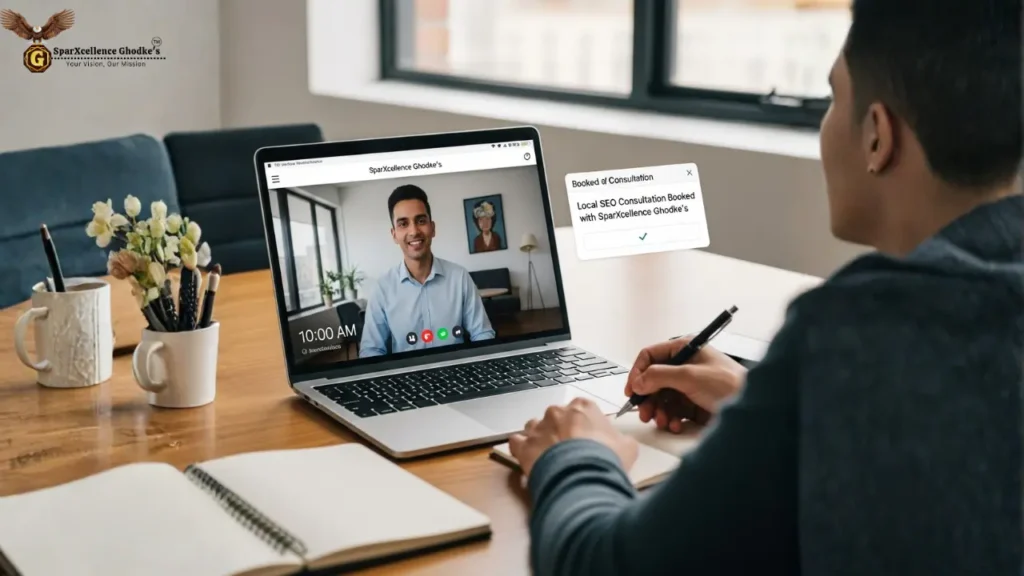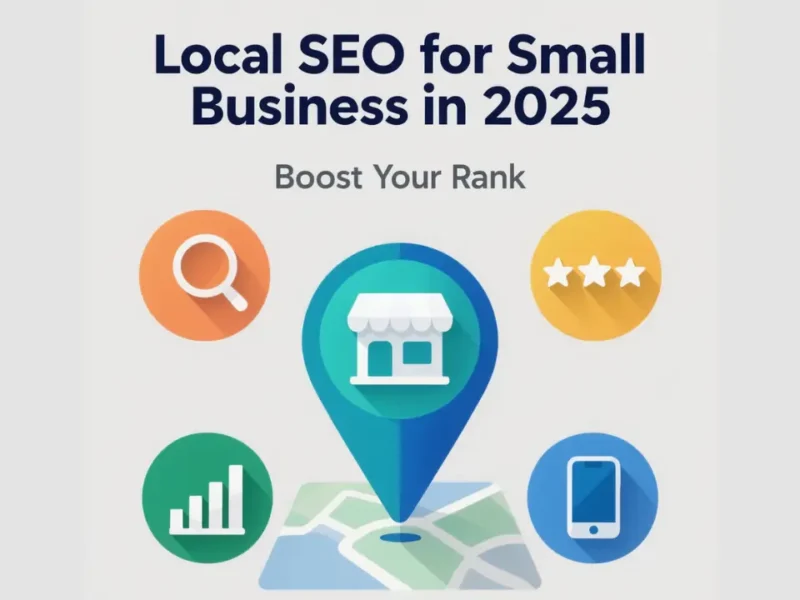If you’ve ever searched “near me” and wondered why one competitor shows up at the top with dozens of glowing reviews while your listing sits below the fold, this guide is for you. Local SEO for Small Business in 2025 is the difference between busy phones and quiet afternoons. The map pack steals attention, mobile rules the journey, and reviews decide tie‑breakers. The good news? You don’t need a big budget. You need the right fundamentals done well, every week.
In this definitive, plain‑English guide you’ll learn exactly how Local SEO for Small Business in 2025 works, what changed in search results this year, and the precise steps that move you up the map and into more wallets without guesswork. We’ll share field‑tested checklists, examples, benchmarks, and FAQs you can hand straight to your team.
Table of Contents
Why Local SEO Matters More in 2025

- The map pack dominates small screens. Most local clicks happen there, not on the organic list below.
- People validate referrals with search. Even when a friend recommends you, prospects check hours, photos, and reviews before calling.
- Zero‑click behavior is normal. Many users find enough info in the listing (reviews, hours, menu, services) to decide without visiting your site.
- Ad costs keep rising; organic local visibility protects margin and compounds with each new review or photo.
Local SEO for Small Business in 2025 is a compounding habit. Each small improvement faster pages, better photos, accurate hours, clearer service pages adds up.
How the Local Pack Decides: Proximity, Relevance, Prominence, Behavior
Google has published the core factors for local ranking for years, and they still apply:
- Proximity — How close you are to the searcher (not fully controllable).
- Relevance — How well your profile and pages match the query (you can control).
- Prominence — How well‑known and trusted your business appears (reviews, links, mentions).
- Behavioral signals — Clicks, calls, direction requests, engagement (better experiences earn better signals).
If you remember nothing else about Local SEO for Small Business in 2025, remember this: optimize what you can control (relevance, prominence, and behavior), and proximity will take care of itself.
Google Business Profile (GBP): The Complete Optimization Checklist

Your profile (formerly Google My Business) is your digital storefront. Treat it like one.
Use this checklist and revisit it monthly:
Category & Core Info
- Choose the most specific primary category (e.g., “Emergency Dentist” vs “Dentist”).
- Add secondary categories that reflect services (not as important as primary).
- Confirm NAP (Name, Address, Phone) exactly as it appears on your site.
- Set hours, holiday hours, and service areas (for service‑area businesses).
- Add your website and appointment link (if available).
Services, Products & Attributes
- List Services with short, benefit‑focused descriptions.
- Add Products (or featured items) with prices/photos if relevant.
- Enable attributes (e.g., women‑owned, parking, wheelchair access, online care).
Photos & Videos (Freshness Matters)
- Upload high‑quality exterior, interior, team, and work‑in‑progress photos.
- Add short clips: 10–20 seconds, vertical, show process or outcomes.
- Update visuals monthly (recency influences engagement and trust).
Posts & Q&A
- Publish Posts for promos, events, or seasonal notes (1–2 per month is plenty).
- Seed Q&A with helpful answers to common questions; respond quickly to new ones.
Messaging & Calls
- Enable Messaging only if your team can respond fast; assign responsibility.
- Use call history to analyze missed calls; adjust hours/coverage if needed.
Reviews (see full section below)
- Create a simple review request flow (QR code at POS, link in follow‑up).
- Reply to every review graciously and specifically.
Resource: GBP help documentation for categories, services, and photos: https://support.google.com/business/answer/3038177?hl=en
How to Earn Reviews (Without Being Pushy)
- Ask right after a positive visit or delivery (time matters).
- Make it easy: short link/QR code; one‑tap paths from email/SMS.
- Train staff to ask politely: “It helps neighbors find us would you mind leaving a quick note?”
- Include printed review cards with the link (offline prompts still work).
Reply Like a Neighbour
- Thank the customer by first name if shown; reference a specific detail.
- For negative reviews: acknowledge, apologize if warranted, and move details offline.
- Never argue. Your real audience is the next prospect reading your reply.
Use Reviews on Your Site
- Embed top reviews on service and location pages; rotate monthly.
- Mark up testimonials with relevant structured data (observe platform rules).
Important: Don’t “gate” reviews (asking only happy customers). It violates platform policies and harms trust.
NAP Data & Local Citations: Consistency Still Matters
Citations are mentions of your Name, Address, and Phone across directories and maps. They’re less “rank‑making” than a decade ago but still foundational to Local SEO for Small Business in 2025.
Steps to Get Them Right
- Audit your core listings: Google, Apple Maps, Bing Places, Yelp, Facebook, and industry directories.
- Ensure NAP consistency (down to abbreviations).
- Fix duplicates and wrong addresses/phones.
- Add niche citations (e.g., law directories for attorneys, Healthgrades for clinics).
- Update whenever your details change.
Tip: Keep a master NAP spreadsheet so you’re not starting from scratch later.
On‑Page SEO for Local: Service Pages, Location Pages, Internal Links, Schema
Even with a perfect profile, your website carries weight. It’s where you prove expertise and convert visitors who click through.
Service Pages
- Create one page per core service; don’t lump everything together.
- Structure: problem → solution → steps → pricing ranges → FAQs → CTA.
- Use local phrasing naturally (neighborhoods, landmarks).
- Add FAQ sections that mirror real calls/emails; mark up with FAQ schema.
Location Pages
- Each location gets a unique page (no copy‑paste).
- Include directions, parking/transit tips, nearby landmarks, hours, phone, and team photos.
- Add an embedded map and “book now” if applicable.
- Link from the main nav, footer, and your GBP.
Internal Links
- From the homepage and category hubs, link to your top services and all location pages.
- Use descriptive anchors (e.g., “emergency AC repair in Midtown”).
Structured Data
- Add LocalBusiness markup; include name, address, phone, hours, and geo coordinates.
- Use Service, FAQPage, and BreadcrumbList schema where relevant.
Resource: LocalBusiness markup reference: https://schema.org/LocalBusiness
Technical Basics That Impact Local Results
You don’t need a perfect Lighthouse score, but you do need a fast, usable site.
- Speed/Core Web Vitals: compress images, lazy‑load below the fold, defer non‑critical scripts, use modern formats (WebP/AVIF).
- Mobile UX: large tap targets; readable fonts; short forms; click‑to‑call buttons.
- Accessibility: alt text, high contrast, keyboard focus, clear labels.
- Indexing: fix 404s, avoid redirect chains; submit a clean sitemap in Search Console.
- Security: HTTPS; no mixed content.
Check speed here: https://pagespeed.web.dev/
Content That Wins Your Neighborhood (Real Ideas)
Content should help real people solve problems not “Hello City!” paragraphs. In Local SEO for Small Business in 2025, usefulness wins.
Ideas That Work
- Seasonal prep: “How to winterize your [service] in [city]”
- Buyer’s guides: “What to know before your first [service] visit”
- Comparison: “DIY vs professional: when to call a pro in [city]”
- Local guides: “Parking and public transit near [business]”
- Behind the scenes: show your process, tools, and team
- Pricing explainer: ranges and what affects them (people appreciate transparency)
Every piece should link to a relevant service or location page and include a soft CTA (“Get a quick quote”).
Local Links & PR: Partnerships, Sponsorships, and Coverage That Count
Quality local links reinforce prominence and trust.
- Join associations (chamber, professional bodies) and get listed.
- Sponsor community events; ask for website mentions.
- Partner with nearby businesses for complementary content (“best [category] near [landmark]”).
- Pitch a helpful column to a local blog/newspaper (“How to choose a [service] in [city]”).
- Support a cause and tell the story online (focus on the impact).
Avoid low‑quality link schemes. Relevance + real value beats sheer volume.
Service‑Area Businesses (SABs): Hidden‑Address Tactics
If you visit customers at their location and don’t accept customers at your address:
- Hide the address on your GBP; set service areas properly.
- Build service area pages carefully (don’t spam dozens of thin pages).
- Prioritize real service zones; include local details, photos of work nearby, and unique copy.
- Citations should match your hidden‑address status; don’t list a storefront you don’t have.
- Encourage reviews that mention the neighborhood (“fast service in [area]!”).
Proximity still matters; cover the closest, highest‑value zones first.
Multi‑Location Playbook: Scale Without Losing the Local Touch
For multi‑location brands, Local SEO for Small Business in 2025 is about consistent execution plus local flavor.
- One GBP per location, with unique photos, posts, and attributes.
- Unique location pages with staff, neighborhood references, and directions.
- Centralized review response playbooks; empower local teams to reply with personality.
- Photo cadences (monthly) and local content calendars.
- Roll‑up reporting with location‑level KPIs (calls, direction requests, website actions).
Avoid copy‑pasting; search engines (and people) spot it.
Measuring What Matters: Tracking, KPIs, and Simple Tools
Local SEO for Small Business in 2025 is measurable if you set up tracking.
Tracking
- Google Business Profile Insights: calls, website clicks, direction requests; breakout by queries.
- Google Search Console: impressions, CTR, ranking distribution for local queries; coverage issues.
- Analytics (GA4 or similar): sessions, goal conversions (calls, forms), events (click‑to‑call, map clicks).
- Call tracking: unique numbers per location/page; track duration and outcomes.
KPIs
- Map pack actions: calls, direction requests, website clicks
- Website conversions: calls, form fills, bookings
- Ranking distribution: Top 3/Top 10 for priority local terms
- Review velocity & average rating
- Engagement: photo views, Q&A responses
- Page health: mobile speed scores, Core Web Vitals pass rate
Report monthly: what changed, what worked, and what you’ll ship next.
Compliance & Risks: What to Avoid
- Review gating (asking only happy customers) violates policies.
- Inaccurate hours frustrate customers; update holiday hours.
- Keyword stuffing in business names can trigger suspensions (and creates poor UX).
- Fake locations / P.O. boxes risk removal from maps.
- Duplicate listings cause confusion merge or remove.
Always align with platform guidelines; it’s part of trust.
Conclusion: Make Local SEO a Weekly Habit Not a One‑Time Project
Winning Local SEO for Small Business in 2025 isn’t about secret tricks. It’s about doing the right basics really well, then repeating them:
- A complete, up‑to‑date Google Business Profile with the right category, services, photos, and hours
- A steady, ethical review pipeline and thoughtful replies
- Useful service and location pages with clear CTAs, local details, schema, and speed
- Consistent citations, relevant local links, and helpful neighborhood content
- Clean tracking and simple KPIs you review monthly

FAQs
How long does Local SEO for Small Business in 2025 take to show results?
Quick wins like improved CTR, photo views, and more calls often appear in weeks. Bigger movement in rankings and steady review growth typically show over 1–3 months, compounding each quarter.
How many reviews do we need?
There’s no magic number. Aim for a steady cadence (weekly), keep average rating healthy, and reply to every review. Recency and quality matter as much as count.
Should I post on Google Business Profile every week?
You don’t have to. One or two useful posts per month (promos, seasonal info, closures) is enough. Photos and accurate info move more needles.
Does social media help local SEO?
Indirectly. Social builds brand searches, content to repurpose on your site, and user‑generated visuals you can add to your profile. It also fuels awareness that becomes “near me” searches.








